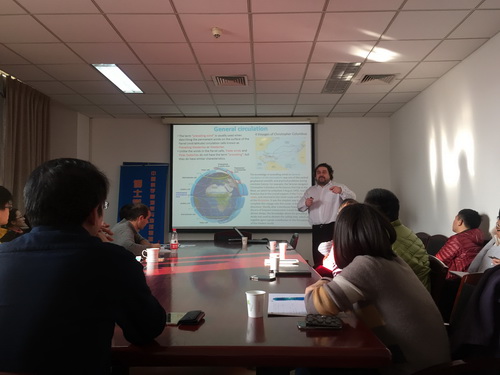|
News
|
2016
Prof. Markovic from University of Novi Sad Visits IGG for Academic ExchangeAt the invitation of Prof. GUO Zhengtang, Prof. Slobodan B. Markovic, a fellow of the Serbian Academy of Sciences, from University of Novi Sad, visited IGG for a three month cooperation with the Key Laboratory of Cenozoic Geology and Environment as an International Visiting Scholar of CAS. On Dec 6th, he gave two academic reports entitled “Prevailing winds in northern Serbia: recent data, geomorphological evidence and numerical simulations” and “Are Serbian Loess-paleosol sequences the most sensitive record that represents Alpine glaciation during the last million years”. In the first report, Prof. Markovic first briefly introduced the characteristics of Serbian atmospheric circulation and then described in detail the statistical results of the meteorological data of prevailing winds and the simulated results of ice-age climate. He lastly discussed the relation between loess deposits and prevailing wind directions. Since Serbia is located at the polar front, the prevailing winds in Serbia exhibit significant variations. According to modern meteorological data, the prevailing winds in Serbia are northwestrly and southeasterly; specifically, the former can give rise to rainfalls and the latter lead to desiccation. Compared with the seasonal variation characteristics of wind directions in the East Asian monsoon area, these two winds with different directions appear alternately in Serbia, showing no obvious seasonal differences. In combination with the variation characteristics of loess depositional areas and the evidence for the distribution of ancient dunes, he proposed that these two prevailing winds both transported dust for loess deposits in Serbia. The preliminary results from climate models suggest that the prevailing wind direction during ice ages is consistent with that in modern times, indicating the similarity between ice ages and interglacial period in climate models. In the second report, Prof. Markovic reviewed research on the ice ages in the Alps, then compared the difference between Serbian and Chinese loess records and finally discussed the possible correlation between Serbian loess and the evolution of ice ages in the Alps. Additionally, he made some proposals for future research. In the past one million years, climate cycles based on Serbian loess magnetic susceptibility agree well with that from Chinese loess, but the sequence of particle-size changes have significant differences. He also explained the material inheritance relationship between Serbian loess and glacial tills from the Alps, and pointed out that the loess in central Serbia may be the mixed deposits of the fine materials from the flood plain of the Danube that was carried by the northwest wind and the near-source coarse materials carried by the southeast wind, while the above-described deposits in dust source regions are the erosions from the Alps carried by the Danube. Therefore, the differences in the variation of grain size between Serbian loess and Chinese loess may be related to the different controlling factors of deposits; the variation of Serbian loess grain size is tightly correlated with the glacial activities in Alps and may contain the important information regarding evolution. After the report, the teachers and students that participated in the conference had a heated discussion with Prof. Markovic on several topics such as Serbian modern climatic characteristics and the comparison of loess between China and Europe.
Prof.Markovic is giving a report(Photo by IGG)
|
-
SIMSSecondary Ion Mass Spectrometer Laboratory
-
MC-ICPMSMultiple-collector ICPMS Laboratory
-
EM & TEMElectron Microprobe and Transmission Electron Microscope Laboratory
-
SISolid Isotope Laboratory
-
StIStable Isotope Laboratory
-
RMPARock-Mineral Preparation and Analysis
-
AAH40Ar/39Ar & (U-Th)/He Laboratory
-
EMLElectron Microscopy Laboratory
-
USCLUranium Series Chronology Laboratory
-
SASeismic Array Laboratory
-
SEELaboratory of Space Environment Exploration Laboratory
-
PGPaleomagnetism and Geochronology Laboratory
-
BioMNSFrance-China Bio-mineralization and Nano-structure Laboratory


